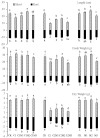Effect of Molybdenum on Plant Physiology and Cadmium Uptake and Translocation in Rape (Brassica napus L.) under Different Levels of Cadmium Stress
- PMID: 32244320
- PMCID: PMC7177489
- DOI: 10.3390/ijerph17072355
Effect of Molybdenum on Plant Physiology and Cadmium Uptake and Translocation in Rape (Brassica napus L.) under Different Levels of Cadmium Stress
Abstract
This study investigated the beneficial effect of molybdenum (Mo) application on rape plants (Brassica napus L.) grown in a soil polluted by cadmium (Cd). A pot experiment was conducted to determine how different concentrations of exogenous Mo (0, 50, 100, and 200 mg/kg) affect plant physiology, biomass, photosynthesis, cation uptake, and Cd translocation and enrichment in rape plants under Cd stress (0.5 and 6.0 mg/kg). Under single Cd treatment, plant physiological and biochemical parameters, biomass parameters, leaf chlorophyll fluorescence parameters, and macroelement uptake of rape plants decreased, while their malonaldehyde content, proline content, non-photochemical quenching coefficient, and Cd uptake significantly increased, compared to those of the control group (p-values < 0.05). High-Cd treatment resulted in much larger changes in these parameters than low-Cd treatment. Following Mo application, the accumulation of malondialdehyde and proline decreased in the leaves of Cd-stressed plants; reversely, the contents of soluble protein, soluble sugar, and chlorophyll, and the activities of superoxide dismutase and glutathione peroxidase, all increased compared to those of single Cd treatment (p-values < 0.05). Exogenous Mo application promoted shoot and root growth of Cd-stressed plants in terms of their length, fresh weight, and dry weight. The negative effect of Cd stress on leaf chlorophyll fluorescence was substantially mitigated by applying Mo. Exogenous Mo also improved the uptake of inorganic cations, especially potassium (K+), in Cd-stressed plants. After Mo application, Cd uptake and accumulation were inhibited and Cd tolerance was enhanced, but Cd translocation was less affected in Cd-stressed plants. The mitigation effect of Mo on Cd stress in rape was achieved through the immobilization of soil Cd to reduce plant uptake, and improvement of plant physiological properties to enhance Cd tolerance. In conclusion, exogenous Mo can effectively reduce Cd toxicity to rape and the optimal Mo concentration was 100 mg/kg under the experimental conditions.
Keywords: cadmium uptake; chlorophyll fluorescence; exogenous molybdenum; physiological parameters; plant biomass.
Conflict of interest statement
The authors declare no conflict of interest. The funders had no role in the design of the study; in the collection, analyses, or interpretation of data; in the writing of the manuscript, or in the decision to publish the results.
Figures


Similar articles
-
5-Aminolevulinic acid ameliorates cadmium-induced morphological, biochemical, and ultrastructural changes in seedlings of oilseed rape.Environ Sci Pollut Res Int. 2013 Oct;20(10):7256-67. doi: 10.1007/s11356-013-1735-5. Epub 2013 Apr 28. Environ Sci Pollut Res Int. 2013. PMID: 23625120
-
Cadmium stress alters the redox reaction and hormone balance in oilseed rape (Brassica napus L.) leaves.Environ Sci Pollut Res Int. 2016 Feb;23(4):3758-69. doi: 10.1007/s11356-015-5640-y. Epub 2015 Oct 24. Environ Sci Pollut Res Int. 2016. PMID: 26498815
-
Protective effect of chitosan on photosynthesis and antioxidative defense system in edible rape (Brassica rapa L.) in the presence of cadmium.Ecotoxicol Environ Saf. 2017 Apr;138:271-278. doi: 10.1016/j.ecoenv.2017.01.009. Epub 2017 Jan 11. Ecotoxicol Environ Saf. 2017. PMID: 28081489
-
Agroecotoxicological Aspect of Cd in Soil-Plant System: Uptake, Translocation and Amelioration Strategies.Environ Sci Pollut Res Int. 2022 May;29(21):30908-30934. doi: 10.1007/s11356-021-18232-5. Epub 2022 Jan 30. Environ Sci Pollut Res Int. 2022. PMID: 35094262 Review.
-
The Uptake, Transfer, and Detoxification of Cadmium in Plants and Its Exogenous Effects.Cells. 2024 May 24;13(11):907. doi: 10.3390/cells13110907. Cells. 2024. PMID: 38891039 Free PMC article. Review.
Cited by
-
Potential Importance of Molybdenum Priming to Metabolism and Nutritive Value of Canavalia spp. Sprouts.Plants (Basel). 2021 Nov 5;10(11):2387. doi: 10.3390/plants10112387. Plants (Basel). 2021. PMID: 34834749 Free PMC article.
-
A Glucuronic Acid-Producing Endophyte Pseudomonas sp. MCS15 Reduces Cadmium Uptake in Rice by Inhibition of Ethylene Biosynthesis.Front Plant Sci. 2022 Apr 14;13:876545. doi: 10.3389/fpls.2022.876545. eCollection 2022. Front Plant Sci. 2022. PMID: 35498658 Free PMC article.
-
The combined effect of Cd and high light stress on the photochemical processes in Arabidopsis thaliana.Photosynthetica. 2025 Jul 8;63(2):182-195. doi: 10.32615/ps.2025.020. eCollection 2025. Photosynthetica. 2025. PMID: 40766736 Free PMC article.
-
Benzylaminopurine and Abscisic Acid Mitigates Cadmium and Copper Toxicity by Boosting Plant Growth, Antioxidant Capacity, Reducing Metal Accumulation and Translocation in Bamboo [Pleioblastus pygmaeus (Miq.)] Plants.Antioxidants (Basel). 2022 Nov 24;11(12):2328. doi: 10.3390/antiox11122328. Antioxidants (Basel). 2022. PMID: 36552536 Free PMC article.
-
Effects of Cd treatment on morphology, chlorophyll content and antioxidant enzyme activity of Elymus nutans Griseb., a native plant in Qinghai-Tibet Plateau.Plant Signal Behav. 2023 Dec 31;18(1):2187561. doi: 10.1080/15592324.2023.2187561. Plant Signal Behav. 2023. PMID: 36938824 Free PMC article.
References
-
- Guo Y., Yang J., Guo J.M., Yang J.X., Zheng G.D., Li Z.T., Chen T.B., Yu B., Ni L., Wen Q., et al. Mechanism of nitrogen, phosphrous and potassium combined application promote absorption, transportation and accumulation of Pb in sunflower (Helianthns annuus L.) J. Plant Nutri. Ferti. 2019;25:1998–2008. doi: 10.11674/zwyf.1847. - DOI
-
- Camara Y.A., Wan Y.N., Yu Y., Wang Q., Li H.F. Effect of selenium on uptake and translocation of arsenic in rice seedlings (Oryza sativa L.) Ecotoxicol. Environ. Saf. 2018;148:869–875. doi: 10.1016/j.ecoenv.2017.11.064. - DOI
-
- Huang Y.Z., Hu Y., Liu Y.X. Heavy metal accumulation in iron plaque and growth of rice plants upon exposure to single and combined contamination by copper, cadmium and lead. Acta Ecolo. Sin. 2009;29:320–326. doi: 10.1016/j.chnaes.2009.09.011. - DOI
Publication types
MeSH terms
Substances
LinkOut - more resources
Full Text Sources

